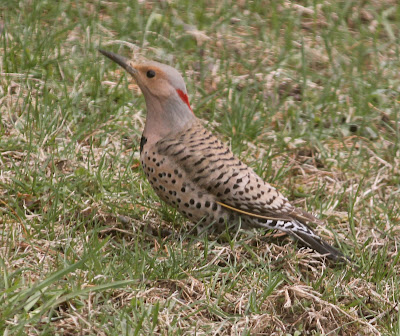Colaptes auratus
All winter I was thinking of this one beautiful woodpecker that appears at Protection Farm only in the spring. They are in WNY year round but they always show up here when the dirt is fresh and wet and all the little critters that they like to eat are just emerging from a long winters sleep. they are never around in the summer, fall, or winter. not sure why. Must be the food is better in the spring.
They are migratory and northern birds move southward in the winter.
Protection Farm Flickers like to eat the native Digger bee’s that nest in the sandy soil between the house and the barn.
The flickers are really quite colorful and have a determined attitude as they forage and dig relentlessly. They are somewhat wary of people, but hang out with many other foraging birds on the ground including cowbirds, junco’s a variety of sparrows, and even bluebirds.
They have long barbed tongues for eating the delicious below ground grubs, ants, beetles, and bees.
The subspecies of Northern Flicker that we have in the east is known as the Yellow-shafted. In the west the bird Northern Flicker subspecies is called the Red-shafted. there are substantial coloration differences including the male "Moustache" or "Malar", which in the Red-shafted is red.
They nest in tree cavities, but have been known to nest in abandoned earth burrows.
The Red-shafted and Yellow-shafted are subspecies of the Northern Flicker. They do hybridize easily.
 |
| The male has a "moustache" aka "malar" |
 |
| The slightly curved bill is perfect for digging in the dirt! |
 |
| these birds have a white patch on their rump which is visible when they fly. I spent two days trying to scare the flickers away so that I could get a shot of the white patch but I have not, so far, been able to get an in focus shot. The Flicker has a very distinctive call, a little like the Pileated: http://www.allaboutbirds.org/guide/Northern_Flicker/sounds |
















































